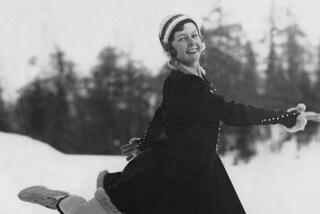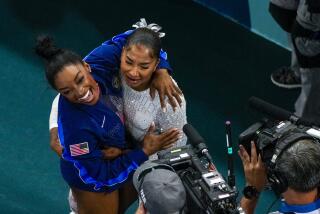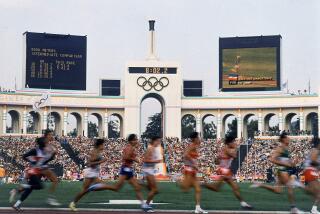The Ice Mother Blazed the Skating Trail for Others
As Mabel Fairbanks watches the Olympics from her Burbank apartment this week, she doesnât wonder what might have been. She knows. If the world had been different 75 years ago, when Mabel was young, she too might have gone for the gold.
But she wasnât even permitted to practice or take lessons. âNo niggers allowedâ are words she heard regularly at ice rinks around New York and L.A. And a sign at Pasadenaâs Winter Garden rink is seared into memory: âColored Trade Is Not Solicited.â
So how did Mabel Fairbanks--who never was accepted into competitive skating, who never got to try for a spot on the U.S. Olympic team--win a coveted place in the U.S Figure Skating Hall of Fame in Colorado Springs, Colo., a few months back? How did she become a living legend, whose inspiring tale is enshrined at the U.S. Figure Skating Museum there? And how did she arrive at a mental place where she can look a visitor in the eye and say with a huge, twinkly smile that she is âhappy and gratifiedâ at the way her life turned out?
âIf I had gone to the Olympics and become a star, I would not be who I am today,â she explains. And who she is, many colleagues agree, is the woman who helped break the color barrier in U.S. figure skating, who became a coach and mentor to youngsters of all races, many of whom became famous and many of whom still call her âmom.â
Among the hundreds she has coached at some point in their careers: Tiffany Chin, Billy Chapel, Scott Hamilton, Kristi Yamaguchi and Rudy Galindo, Tai Babilonia and Randy Gardner, Richard Ewell and Michelle McCladdie, Debbie Thomas, Atoy Wilson, Jean Yuna . . . her voice trails off. As a teacher, she also became known in the â50s and â60s as the âinstructor to the stars and their kids.â Asked to review that list, she rolls her eyes and starts: âI taught Danny Kaye, Vera Ellen, Tony Franciosa, Ricardo Montalban, Nat Coleâs daughter Natalie, Eartha Kitt and her daughter, Jimmy Duranteâs wife and daughter, Dean Martinâs whole family, the daughters of Hedy Lamar, Betty Hutton and Robert Stack, Otto Premingerâs kids, Ozzie and Harrietâs son Ricky, Bing Crosbyâs granddaughter Kelly . . . .â Her voice, weakened from illness, fails before her memory does.
Robin McCarthy, a figure skating instructor in West L.A., first heard of Fairbanks as a child in Atlanta. âI was white, and so was my teacher. But she used to talk about this black skater named Mabel.â McCarthy came west in the â60s and met Fairbanks at the Culver City rink. âShe was forging the way for black skaters who came after her. She fought for them, and eventually got the skating clubs to start accepting them. Those too poor for lessons she taught for free. And she bought them skates. She worked tirelessly.â
These days, Fairbanks, 83, lives in a small senior citizens apartment in Burbank, surrounded by awards, mementos and a table full of medications to ease the effects of myasthenia gravis, a muscle-wasting disease that was diagnosed last year. Although she has limited movement and a weakened voice, her mind and spirit are in full throttle.
Just last week she gave McCarthy a lesson at a local rink. âI canât get on the ice any more, but I can still sit rinkside and give lessons to experts,â she says.
âI donât know where Iâd be without Mabel,â says Tai Babilonia, who with partner Randy Gardner won the U.S National Pairs championships from 1976 through 1980 and the World Pairs championship in 1979. The couple withdrew from the 1980 Olympics due to a pulled groin muscle sustained by Gardner right before they were to compete. They turned professional and are celebrating their 30th anniversary as pairs skaters this year. It was Fairbanks who thought of putting the two together when Babilonia was 8 and Gardner was 10.
âI donât know what made her see us as a pair, but it was a brilliant idea, and I remember it vividly,â Babilonia recalled. âOne day she said, âTai, skate around the rink with Randy, holding hands. I was shy and scared. But we did it. From then on, she bribed me with Barbie dolls and clothes to make me practice with him. âShe was like a second mommy to me.â
Leslie Robinson, 48, was just a kid in the â60s when he went to the Polar Palace in Hollywood for the first time. âThere she was, with her red hair and her pink skates, looking fabulous. It was love at first sight. Each year she took her students to the Ice Capades. There were no black skaters in the show until 1966 when they hired some for the chorus. But she knew something was about to break. She got me an audition.â Robinson went on to skate at the Ice Follies in Las Vegas, one of the first African Americans to be hired as a principal skater there, he says.
Another of Fairbanksâ students, Atoy Wilson, was âthe first African American principal skater with a major ice show,â Robinson says. âMabel helped him get that job. She was like a mother to so many of us.â
It is mind-boggling to realize that in the late 1960s and early 1970s, when African Americans were first breaking into starring roles in professional ice shows, Fairbanks was already in her 50s and had been skating for 40 years. She had managed this career without benefit of any sponsorship from the clubs who trained and raised funds for skaters, and without a salary from any major U.S. ice show.
Her life story would make a wonderful film; its pathos made a visitor teary-eyed the other day. âDonât cry dear,â she said. âIâve cried enough for all of us.â
Born in Florida, Fairbanks never knew her father. Her mother died when she was 8. First she lived with a teacher in Florida, âwho treated me like a maid.â Then she was shipped to New York to live with an older brother, whose wife kicked her out.
Mabel was a pretty, petite, graceful little girl, who was too young to get a job. So she slept on stoops and in Central Park, she says. And thatâs where a wealthy young mother found her, and hired her to baby-sit. When she looked out the womanâs huge living room window and saw skaters twirling, jumping and gliding on the parkâs frozen lake, Fairbanks knew her fate was sealed.
She bought used skates at a pawn shop for $1 and taught herself to glide, jump and twirl. She went to the free skating sessions at the park. But she couldnât afford lessons, and the rinks wouldnât allow blacks in, she says. Finally, at the Gay Blades Ice Casino, on Broadway and 52nd Street, she met some professional instructors who couldnât resist her charms.
Even Fairbanks doesnât know how she got the moxie to make her moves. âI wanted to train for the Olympics. So I went to black doctors, lawyers, teachers, anyone I could think of who might help fund lessons and everything Iâd need. They all said, âGo away little girl.â â
She earned money by being the only black skater in some of the many small ice shows performed in nightclubs during that era. She was never a part of the cast, she recalls, but was always billed as the âextra added attraction.â And she was not permitted to perform the dazzling, world-class maneuvers of which she was capable, she says, because ânone of the white skaters wanted to be outshone by someone black.â
She earned more money traveling with ice shows to Mexico and other countries where people of color were accepted. And when she came to Los Angeles in 1940, she started knocking down barriers again. Eventually, she built a career as a coach to aspiring professionals and a teacher to kids who just wanted to skate for fun. Her big house in Laurel Canyon was open to all.
Atoy Wilson, in his letter nominating her to the Hall of Fame, wrote: â . . . without her trailblazing . . . attempts at integrating skating clubs and competitions and professional ice shows, I never would have had the opportunity of becoming the first African American to win a U.S. national title, followed by a rewarding professional career. The honors held by Richard Ewell, Michelle McCladdie, Bobby Beauchamp, Tai Babilonia and other skaters of color would never have been possible without the tenacious will of this most unique woman.â
Mabel Fairbanks never married, but she is not alone in her golden years. The kids she coached are grown now, and they still call, visit, ask her advice and heap love on her. In Mabelâs mind, this renewable harvest of a lifetime of loving work far exceeds what might have been if she had been allowed to try for that Olympic gold medal.
More to Read
Go beyond the scoreboard
Get the latest on L.A.'s teams in the daily Sports Report newsletter.
You may occasionally receive promotional content from the Los Angeles Times.






